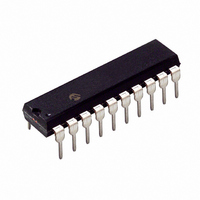High Performance RISC CPU:
• C Compiler optimized architecture/instruction set
• 256 bytes data EEPROM
• Linear program memory addressing to 16 Kbytes
• Linear data memory addressing to 512 bytes
• Up to 16 MIPS operation
• 16-bit wide instructions, 8-bit wide data path
• Priority levels for interrupts
• 31-level, software accessible hardware stack
• 8 x 8 single-cycle hardware multiplier
Flexible Oscillator Structure:
• Precision 16 MHz internal oscillator block:
• Four crystal modes up to 64 MHz
• Two external clock modes up to 64 MHz
• 4X Phase Lock Loop (PLL)
• Secondary oscillator using Timer1 @ 32 kHz
• Fail-Safe Clock Monitor
• Two-Speed Oscillator Start-up
Special Microcontroller Features:
• Full 5.5V operation
• Low voltage option available for 1.8V-3.6V
• Self-reprogrammable under software control
• Power-on Reset (POR), Power-up Timer (PWRT)
• Programmable Brown-out Reset (BOR)
• Extended Watchdog Timer (WDT) with on-chip
• Programmable code protection
• In-Circuit Serial Programming™ (ICSP™) via
• In-Circuit Debug via two pins
Power Managed Modes:
• RUN – CPU on, peripherals on
• IDLE – CPU off, peripherals on
• Sleep – CPU off, peripherals off
• Sleep – current down to 300 nA, typical @ 3.0V
• Watchdog Timer – 1.0 μA typical @ 3.0V
• Timer1 oscillator – 1 μA typical @ 3.0V with
© 2008 Microchip Technology Inc.
- Factory calibrated to ± 1%
- Software selectable frequencies range of
- 64 MHz performance available using PLL –
- Allows for safe shutdown if peripheral clock
operation
and Oscillator Start-up Timer (OST)
oscillator and software enable
two pins
32 kHz crystal
31 kHz to 16 MHz
no external components required
stops
20-Pin High-Performance Flash Microcontrollers
Advance Information
PIC18F1XK22
Analog Features:
• Analog-to-Digital (A/D) Converter module
• Analog Comparator module with:
• Voltage Reference module with:
Peripheral Features:
• 17 I/O pins and 1 input only pin:
• Three external interrupt pins
• Four Timer modules:
• Enhanced Capture/Compare/PWM (ECCP)
• Master Synchronous Serial Port (MSSP) module
• Enhanced Universal Synchronous Asynchronous
• SR Latch (555 Timer) module with:
- 10-bit resolution
- 12 analog input channels
- Auto acquisition capability
- Conversion available during Sleep
- Two rail-to-rail analog comparators
- Comparator inputs and outputs externally
- Programmable on-chip voltage reference
- Fixed voltage reference (FVR) with multiple
- High current sink/source 25 mA/25 mA
- Individually programmable weak pull-ups
- Individually programmable interrupt-on-pin
- 3 16-bit timers/counters with prescaler
- 1 8-bit timer/counter with 8-bit period register,
- Dedicated, low-power Timer1 oscillator
module with:
- One, two or four PWM outputs
- Selectable polarity
- Programmable dead time
- Auto-shutdown and Auto-restart
- PWM output steering control
with Two Modes of Operation:
- 3-wire SPI (supports all 4 SPI modes)
- I
Receiver Transmitter module (EUSART)
- Supports RS-232, RS-485 and LIN 2.0
- Auto-Baud Detect
- Auto Wake-up on Start bit
- Configurable inputs and outputs
- Supports mTouch™ capacitive sensing
accessible and configurable
(CV
reference voltages
change
prescaler and postscaler
with address masking)
applications
2
C™ Master and Slave modes (Slave mode
REF
) module (% of V
DD
)
DS41343A-page 1












